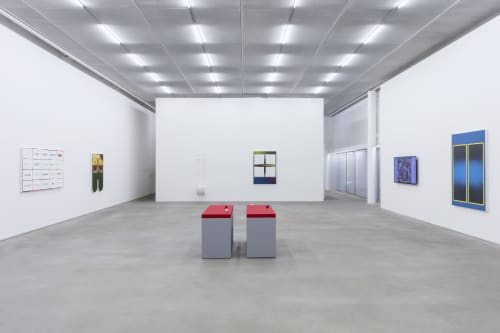Tony Camargo: Num Logo Lugar: Casa Triângulo, São Paulo, Brazil
Perceiving all the spaces
Tony Camargo’s work has always involved the construction of apparatuses which in some way reveal the operation of the world, grasping discoveries of the real in determined spaces, between lines and planes, and conferring to the objects an unforeseen expressive vocation. The invisible probability of the trajectory of pool balls, a dartboard that defies its attributes to become solid and impenetrable even in its opaque reflection, the ironic transformation of marketing logos, depraving their characteristic imagetic modesty.
The artist tames the inner nature of things, thereby modulating a landscape imbued with the magic by which real things are transfigured into pure visuality. Tony’s encounter with art is an encounter of intangible atmospheres with the weight of objects. We could say that his work is that of a conceptual artist, a scientist of the concept, who with each new artwork discovers other contingencies of matter. Tony Camargo is interested in the effect of all the things we see when their originally attributed functions are suspended.
Designing the world
How to construct physical shelters for ideas? How to make invisible materials into something tangible, without being restricted to representation, maintaining complex spatial and temporal dynamics? Tony Camargo’s work shows how primitive we still are, even with our most advanced technological processes. The few formal elements we have available are combined infinite times by designers, producing everything in the landscape of our everyday life.
Look around you: oval circles on doorknobs and door systems, squares, rectangles and their derived triangles in buildings, distances formed by lines on the streets and the urban traffic signs, as well as many other shapes that structure of our society, its gestures and behaviors. In terms of references to art, observing only his use of circles and spheres, there are clear references spanning from Jan van Eyck (The Arnolfini Portrait, 1434) to Jeff Koons (Moon, 1995–2000), passing through Yayoi Kusama (Narcissus Garden, 1966–) and many others.
Dancing with Devils
His lines, planes and oval forms or arcs can allude to either works of classical architecture or recent film fiction. Even his apparent voids possess mass, just as astrophysics has revealed that what was believed to be a large void actually contains mass as well, configuring (dark) matter and energy. Working with primitive memory, the artist is fascinated by the instability of color. As though in the presence of flames that consume the invisible. He knows that the taming of this cosmic energy is what forges our visuality. Color field paintings: Mark Rothko and Barnett Newman. Emotional fields of color: Joseph Albers and Alfredo Volpi.
It is as though after years of revealing the operation of images, Tony were proposing to reproduce an energetics based on the grasping of colors in delimited fields, in this case the painting in its planar sphere. The blues vibrate in their circles and give rise to borders. A patch of gray in coercion spins on a tone like bluish lead. Bordering at the limit. A blue windstorm. Further ahead, other grays. This time, they are separated. The incandescent presence of the red casts its glow on everything around. How is a gray tone a heat source? An asphalt-gray.
Between the spear and the abyss
The roughness of the world is a daily violence. Nothing can be clearer than it is in an advertisement for margarine or in an Instagram account. There is always something noxious, which villainizes, pollutes and annoys: the powerful bewitching of reality, which makes us different from the imagetic insipidity where there are no odors or dirtiness.
The artist thus invites us to an abyss of projections. As in Tunga, based on a complex plasticity that provides its game of free associations, the articulation of the materials is also a symbolic articulation. Its green is not only the green of a composition, but also the green of the Brazilian flag, creating an emotional texture for what we see. Its red is intensity, but also smoke, flames, and a fire extinguisher.
The artist always seeks a pictorial phenomenon of existence. In it we can find a both a tactile void of pure, visual sensations of reality, as well as a sidereal fullness of limpid scenes suspended in space. Between one thing and the other, the atmosphere achieved by each of his works maintains a continuously vibrating body.
Arthur do Carmo (Feb. 2016 – Jan. 2019)


